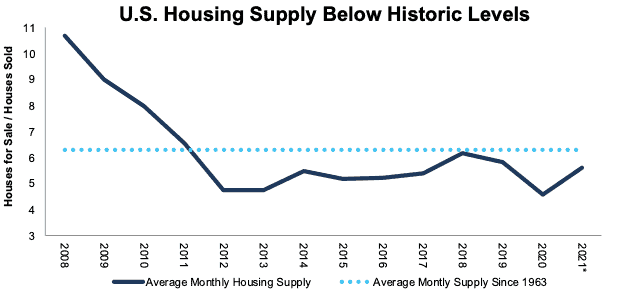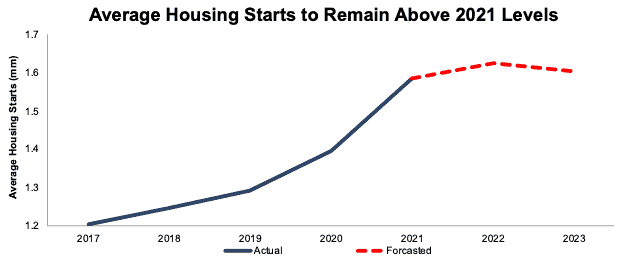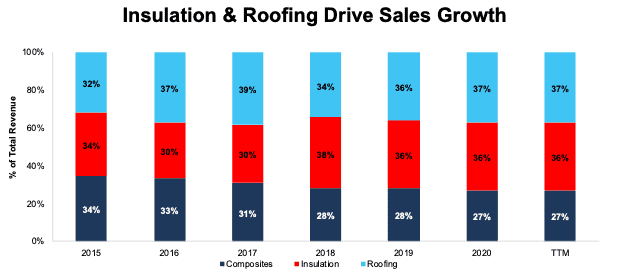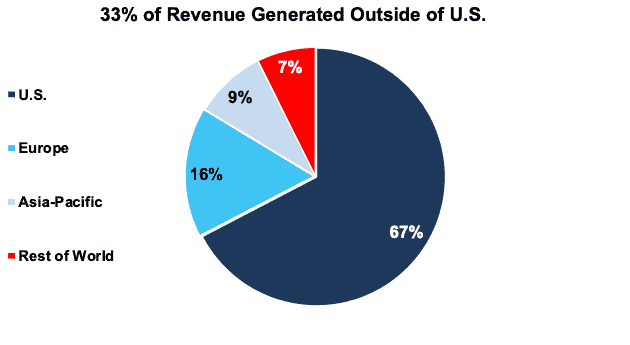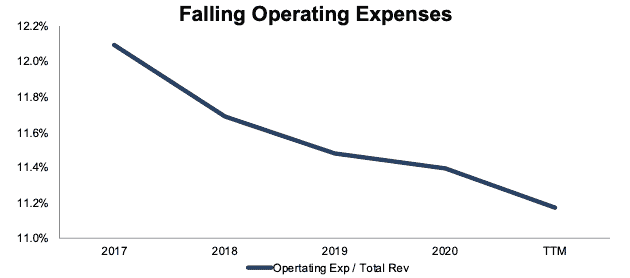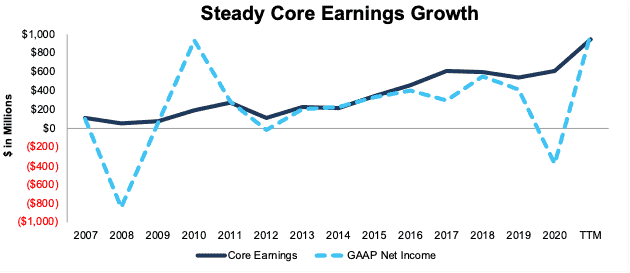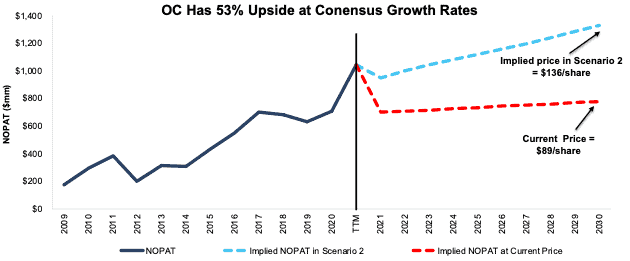We published an update on OC on March 1, 2023. A copy of the associated Earnings Update report is here.
With the Nasdaq down 14% year-to-date, and many stocks down much more, the market is losing its appetite for high-flying momentum names and turning to stocks of undervalued companies with strong fundamentals. Owens Corning (OC: $89/share) is positioned to benefit from decarbonization and aligns management compensation with shareholder returns, and it is this week’s Long Idea.
OC presents quality risk/reward given the company’s:
- position to benefit from several long-term tailwinds
- market share and low-cost leader in the insulation market
- vertically integrated supply chain
- superior profitability to peers
- current valuation implies profits will drop 25% over the next ten years
Demand for New Housing Remains Strong
As the largest producer of building insulation in North America and the second largest producer of asphalt shingles in the U.S., Owens Corning is well positioned to continue to grow profits as the available U.S. housing supply remains below historic averages.
Per Figure 1, since a sharp fall from 2008 – 2012, the U.S. housing supply has remained below its historic average. The average monthly supply of housing since 1963 is 6.3 houses for sale per house sold, while the average housing supply in the first 11 months of 2021 was just 5.6.
Figure 1: U.S. Housing Supply from 2008 – 2021
Sources: New Constructs, LLC and FRED
*2021 is the average from 1/1/2021 – 11/30/2021, the latest available data
New Home Construction Drives Growth Opportunity
Demand for insulation (36% of Owens Corning’s trailing-twelve-month revenue) is highly correlated with new home construction. Per Figure 2, the average number of new home starts rose from 1.2 million in 2017 to nearly 1.6 million in 2021. Looking ahead, the National Association of Homebuilders expects housing starts in 2022 and 2023 to grow above 2021 levels. We expect that Owens Corning’s sales will benefit from increasing housing starts over the coming years.
Figure 2: Historical & Forecasted Average Housing Starts: 2017 – 2023
Sources: New Constructs, LLC and NAHB.
Positioned to Benefit from a Strong Building Market
Owens Corning has shifted more of its business away from its industrial-focused composites segment to its building materials-focused insulation and roofing segments over the past five years. Per Figure 3, the firm’s insulation and roofing segments accounted for 64% of total revenue in 2015 but have grown to 73% of total revenue over the trailing twelve months (TTM). By increasing its concentration on building materials, the firm is well-positioned to benefit from favorable long-term construction trends.
Figure 3: Owen Corning’s Operating Sales Mix: 2015 – 2021
Sources: New Constructs, LLC and company filings
Increased Repairs and Remodels Drive Roofing Demand
In 2020, repair and remodeling accounted for the majority of the asphalt shingle use in the U.S. Since older homes need more repairs and renovation than newer homes, the growing age of the U.S. housing stock adds additional support for the long-term demand for Owens Corning’s roofing products. Years of underbuilding after the housing bubble burst led to a sharp increase in the average age of homes in the U.S. from 34 years in 2007 to 41 years in 2019.
The second largest use of asphalt singles in 2020 was weather damage repair. Over the past 50 years, weather-related disasters have increased by 5x. The firm’s roofing segment will see continued growth should weather disasters, and their costly damage, continue going forward.
Decarbonization Drives Renovation Demand…
With 39% of global energy-related emissions attributed to buildings, the growing number of zero-carbon policies will provide additional long-term demand for the building industry. As the leading provider of building insulation in the U.S., Owens Corning is well positioned to benefit from this growing interest in the energy efficiency of buildings. For example, the firm’s PINK Next Gen Fiberglass insulation saves 12x as much energy in its first year of use as it takes to produce it. In total, ~60% of the firm’s 2020 revenue was generated from energy-saving and renewable products.
…and Europe Will Lead the Way
With Europe’s increasing focus on decarbonizing its building stock, large-scale building renovations could be a significant growth driver for Owens Corning for decades to come. The European Green Deal Commission’s proposal focuses on making its building stock much more energy efficient. The Commission proposed that the worst-performing 15% of each member state’s building stock upgrade its energy performance grade by 2027. The firm is ready for green-marketing as recycled content comprises anywhere from 53% to 73% of the firm’s fiberglass insulation products.
While 67% of Owens Corning’s revenue is generated within the U.S., its international business is growing, particularly in Europe. The firm’s European revenue grew from just 10% of total revenue in 2015 to 16% TTM.
Figure 4: U.S. Vs. International Sales: TTM
Sources: New Constructs, LLC and company filings
Vertically Integrated Operation Reduces Supply Chain Risk
As with nearly every other business, supply chain disruptions have challenged Owens Corning. However, Owens Corning’s vertical integration reduces exposure to unexpected disruption. Indeed, the global supply chain snarl provides OC an opportunity to take market share from more constrained competitors, which is exactly what the firm has done over the TTM. Combined, the firm’s U.S. insulation and roofing segments improved their TTM share of the U.S. retail building materials market from 1.2% in 3Q20 to 1.3% in 3Q21.
Rising Costs Pressure Margins but Create a Growth Opportunity
The rising cost of labor, energy, raw materials, and transportation could pressure the firm’s margins in the short term. However, the company has historically been able to pass costs along to its end users. Indeed, since fiberglass insulation is lower cost than other forms of insulation, builders looking to lower materials costs will be more likely to consider fiberglass.
Owens Corning can also help builders reduce labor costs with its PINK Next Gen Fiberglass insulation product, which requires 23% less time to install than the firm’s EcoTouch product. Faster installation translates to lower labor costs.
Beyond building materials, the lightweight nature of fiberglass products makes them an increasingly competitive alternative to traditional materials. In an environment of rising transportation costs, we expect increased demand for lightweight fiberglass products. For example, the firm’s fiberglass rebar is 75% lighter than steel.
Fear of Rising Interest Rates Is Overstated
The fear that rising interest rates will dramatically stall construction demand ignores the fact that the U.S. housing supply is still below historical levels. Furthermore, the NAHB’s housing starts forecast, which projects growth in the next two years, already assumes an increase in the prime rate from 3.25% in 2021 to 5.61% in 2023.
Even if interest rates rise too high too fast, there are plenty of political measures that could address a rise in the cost of housing, given its impact on every stratum of society. Governmental programs already exist to assist first-time home buyers, families that lose a house due to a disaster, and owners of homes that use energy efficient building materials. These or other programs could expand and offset the increased cost of housing that rising interest rates would cause.
Demand for Asphalt Shingles Will Grow Despite Popularity of Solar
Skeptical investors may fear that the rising demand for solar shingles and roof-based solar panel installations will threaten asphalt shingle manufacturers like Owens Corning. Given their higher expense, solar shingles will not replace the much cheaper asphalt shingles any time soon. Market research provider ReportLinker expects asphalt shingles to grow at a 3.4% CAGR through 2027.
Beyond solar shingles, solar panels are placed on top of traditional roofing materials, thereby creating little impact on the demand for roofing materials. While panels can add extra protection from exposure to sun and weather and extend shingle life, the productive lifetime of panels is only 25-30 years. Furthermore, owners installing solar panels need a relatively new roof to make the solar panel investment worthwhile, which could cause solar panel buyers to replace their shingles sooner than they otherwise would.
Innovation Ensures the Firm Stays Relevant
Though the firm’s core business has plenty of drivers for growth over the long term, the company invests to enhance its current product lines and develop new end markets. Here are some of the firm’s innovations:
- Renewable Energy: WindStrand enables wind turbines to generate more affordable renewable energy
- Insulation: Foamular NGX meets or exceeds more stringent environmental regulatory standards
- Flooring: Sustaina composites are composed of 35% to 100% recycled material
- Infrastructure: Fiberglass rebar is lighter, stronger, and more durable than steel rebar
- Prefab Building Materials: ResidentialComplete Wall Systems offer a complete, energy efficient solution for residential projects
Driving Operating Expenses Lower
Even though the firm has been investing in innovative products, it has managed to lower its operating expenses (marketing and administrative, science and technology, and other) as a percent of total revenue. Per Figure 5, Owens Corning’s operating expenses have steadily fallen from 12.1% of revenue in 2017 to 11.2% of revenue over the TTM.
Figure 5: Operating Expenses as a % of Revenue: 2017 – TTM
Sources: New Constructs, LLC and company filings
More Profitable Than Other Building Material Peers
Owens Corning’s vertically integrated supply chain and economies-of-scale drive industry-leading profitability. Owens Corning has the highest NOPAT margin and return on invested capital (ROIC) of all peers in Figure 6. Peers include other publicly traded building material firms Beacon Roofing Supply, Inc. (BECN), Cabot Corporation (CBT), Huntsman Corp (HUN), Carlisle Companies, Inc (CSL), and Dupont De Nemours Inc. (DD).
Figure 6: Owens Corning’s Profitability Vs. Peers: TTM
Sources: New Constructs, LLC and company filings
Core Earnings Reveal Consistent Growth
Figure 7 illustrates that Owens Corning’s volatile GAAP earnings provide an unfavorable impression of the true profitability of the company. The firm’s Core Earnings are much less volatile than GAAP earnings and have grown from $107 million in 2007 to $938 million over the TTM.
Figure 7: Owens Corning’s Revenue & Core Earnings Since 2007
Sources: New Constructs, LLC and company filings
OC Has 53% Upside If Consensus Is Right
Below we use our reverse discounted cash flow (DCF) model to analyze the future cash flow expectations baked into Owens Corning’s stock price. We also provide an additional scenario to highlight the upside potential in shares if Owens Corning simply grows revenue at consensus rates.
DCF Scenario 1: to Justify the Current Stock Price.
If we assume Owens Corning’s:
- NOPAT margin falls to 10% (5-year average) in 2021 through 2030 and
- revenue grows at a 1% CAGR (vs. 2021 – 2023 consensus estimate CAGR of 9%) from 2021 – 2030, then
the stock is worth $89/share today – equal to the current stock price. In this scenario, Owens Corning earns $780 million in NOPAT in 2030, or 25% below the TTM.
DCF Scenario 2: Shares Are Worth $136+.
If we assume Owens Corning’s:
- NOPAT margin falls to 11% (vs. 13% over the TTM) from 2021 through 2030,
- revenue grows at a 9% CAGR from 2021 - 2023, and
- revenue grows at a 3.5% CAGR from 2024-2030 then
the stock is worth $136/share today – a 53% upside to the current price. In this scenario, Owens Corning’s NOPAT grows 7% compounded annually for the next decade. For reference, Owens Corning grew NOPAT 10% compounded annually from 2015 to 2020, and TTM NOPAT is 47% above 2020 levels. Should Owens Corning’s NOPAT grow in line with historical growth rates, then the stock has even more upside.
Figure 8 compares Owens Corning’s historical NOPAT to its implied NOPAT in each of the above DCF scenarios.
Figure 8: Owens Corning’s Historical and Implied NOPAT: DCF Valuation Scenarios
Sources: New Constructs, LLC and company filings
Sustainable Competitive Advantages Will Drive Shareholder Value Creation
Here’s a summary of why we think the moat around Owens Corning’s business will enable it to continue to generate higher NOPAT than the current market valuation implies.
- low-cost insulation provider
- leading U.S. insulation market share
- increased focus on high-margin products
- investment in high-efficiency products to meet future demand
- high profitability compared to peers
What Noise Traders Miss With Owens Corning
These days, fewer investors focus on finding quality capital allocators with shareholder friendly corporate governance. Instead, due to the proliferation of noise traders, the focus is on short-term technical trading trends while more reliable fundamental research is overlooked. Here’s a quick summary of what noise traders are missing:
- the ongoing shortage of housing supply
- the aging existing houses and demand for repairs
- consistent Core Earnings growth
- forecasted elevated housing starts through 2023
- valuation implies profits in 2030 will be 25% below TTM levels
Earnings Beats or a Jump in Housing Starts Could Send Shares Higher
According to Zacks, Owens Corning has beaten earnings estimates by more than 20% in five of the past six quarters. Doing so again could send shares higher.
A rise in forecasted housing starts for 2022 – 2023 above 1.6 million would also signal a stronger than expected demand for building materials, which could lead to gains for Owens Corning’s shares.
Additionally, extreme weather events could cause an increase in demand for the company’s building materials and could cause a jump in both its sales and shares.
Dividends and Share Repurchases Could Provide 8.9% Yield
Owens Corning has paid a dividend in every year since 2014. Since 2016, Owens Corning has paid $461 million (5% of current market cap) in cumulative dividends. The firm’s current dividend, when annualized, provides a 1.6% yield.
Owens Corning also returns capital to shareholders through share repurchases. From 2016 to 2020, the firm repurchased $1.0 billion (11% of current market cap) of stock. Owens Corning has repurchased $657 million over the TTM. If the company continues to repurchase shares at the same rate, the buybacks will provide an annual yield of 7.3% at its current market cap.
Executives’ and Shareholders’ Interests Are Aligned
No matter the macro environment, investors should look for companies with executive compensation plans that directly align executives’ interests with shareholders’ interests. Quality corporate governance holds executives accountable to shareholders by incentivizing them to allocate capital prudently.
Owens Corning compensates executives with salaries, annual bonuses, and long-term equity awards.
Thirty-five percent of the company’s long-term performance share awards are based on adjusted return on capital (ROC) and free cash flow conversion targets over a three-year performance period. The use of metrics similar to ROIC is a great start at properly incentivizing executives.
However, Owens Corning’s calculation of return on capital is not perfect. The company overstates the true return it generates on all capital invested in its business. The company calculates ROC as adjusted EBIT plus fresh start depletion and amortization less adjusted taxes divided by the sum of average net fixed assets, average working capital, goodwill and intangible assets less fresh start land and alloy adjustments.
The company’s inclusion of depletion and amortization in its calculation of earnings fails to capture the true profitability of the firm. Furthermore, the company’s calculation of capital does not account for all depletion and amortization or asset write-downs, as our average invested capital does. From 2018 through 2020, the firm’s calculation of ROC was 11.9%, 9.6%, and 10.7%, respectively, compared to our ROIC calculation of 7.2%, 6.5%, and 7.3% over the same time.
Despite the drawbacks and room for improvement, Owens Corning’s use of ROC stands out in a market filled with compensation programs unrelated to creating shareholder value. Tying executive compensation to ROIC, or something similar, ensures that executives’ interests are aligned with shareholders’ interests as there is a strong correlation between improving ROIC and increasing shareholder value.
Owens Corning’s focus on creating shareholder value has helped it grow economic earnings from -$16 million in 2015 to $528 million TTM.
Insider Trading and Short Interest Trends
Over the past 12 months, insiders have bought 108 thousand shares and sold 100 thousand shares for a net effect of ~8 thousand shares purchased. These purchases represent less than 1% of shares outstanding.
There are currently 2.8 million shares sold short, which equates to 3% of shares outstanding and just over three days to cover. Short interest is unchanged from the prior month. The lack of short interest reveals not many are willing to bet against this leading building materials supplier.
Critical Details Found in Financial Filings by Our Robo-Analyst Technology
Fact: we provide more reliable fundamental data and earnings models – unrivaled in the world.
Proof: Core Earnings: New Data & Evidence, forthcoming in The Journal of Financial Economics.
Below are specifics on the adjustments we make based on Robo-Analyst findings in Owens Corning’s 10-K and 10-Qs:
Income Statement: we made $1.2 billion of adjustments, with a net effect of removing $1.1 billion in non-operating expenses (15% of revenue). You can see all the adjustments made to Owens Corning’s income statement here.
Balance Sheet: we made $2.2 billion of adjustments to calculate invested capital with a net increase of $1.5 billion. One of the largest adjustments was $1.1 billion in asset write-downs. This adjustment represented 14% of reported net assets. You can see all the adjustments made to Owens Corning’s balance sheet here.
Valuation: we made $4.9 billion of adjustments to shareholder value for a net effect of decreasing shareholder value by $3.8 billion. Apart from total debt, one of the most notable adjustments to shareholder value was $505 million in excess cash. This adjustment represents 6% of Owens Corning’s market cap. See all adjustments to Owens Corning’s valuation here.
Attractive Fund That Holds OC
The following fund receives our Attractive rating and allocates significantly to OC:
- State Street SPDR S&P Homebuilders ETF (XHB) – 2.9% allocation
This article originally published on January 26, 2022.
Disclosure: David Trainer, Kyle Guske II, and Matt Shuler receive no compensation to write about any specific stock, style, or theme.
Follow us on Twitter, Facebook, LinkedIn, and StockTwits for real-time alerts on all our research.

